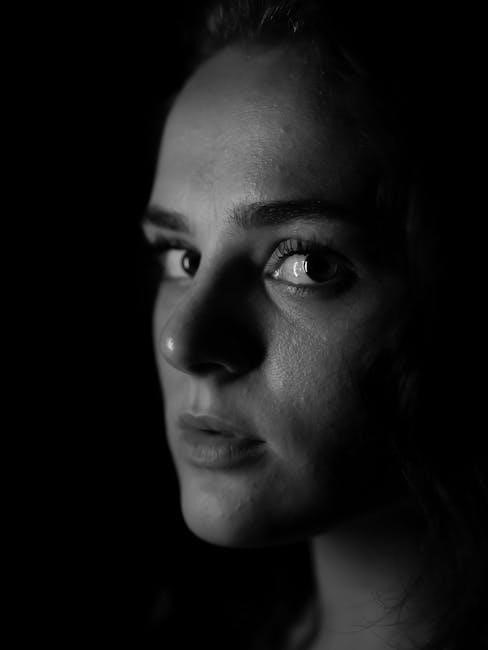
The Reconfigured Eye: Visual Truth in the Post-Photographic Era
William J. Mitchell’s seminal work explores the intersection of photography and digital technology, examining how visual truth is redefined in the post-photographic era. Available as a PDF, the book provides a critical analysis of image manipulation and its implications on authenticity, offering insights into the evolving role of photography in a digital world.

The post-photographic era, as explored in William J. Mitchell’s The Reconfigured Eye, marks a significant shift in how we perceive and interact with images. This concept refers to the transition from traditional film-based photography to digital imaging technologies. With the advent of digital tools, the nature of visual representation has fundamentally changed, challenging long-held notions of photographic truth. In this era, images are no longer fixed or static but can be endlessly manipulated, altered, and reproduced. Mitchell argues that this transformation raises critical questions about authenticity, truth, and the role of photography in contemporary culture. The post-photographic era is characterized by the democratization of image creation and the blurring of boundaries between reality and fabrication. This shift has profound implications for art, journalism, and everyday communication, as the trust we once placed in photographs as objective records is increasingly called into question. Mitchell’s work provides a foundational framework for understanding these changes and their broader societal impact.
The Evolution of Photography and Digital Technology
The evolution of photography and digital technology has been a transformative journey, reshaping how images are created, edited, and consumed. According to William J. Mitchell’s The Reconfigured Eye, the transition from film to digital photography has revolutionized the medium. Early photographic processes, such as daguerreotypes and wet plate collodion, were labor-intensive and limited in their reproduction capabilities. The advent of roll film by George Eastman in the late 19th century made photography more accessible, leading to the widespread use of cameras in the 20th century. The digital revolution of the late 20th and early 21st centuries introduced new tools like image sensors, software editing, and sharing platforms, enabling unprecedented manipulation and distribution of images. This technological progression has not only altered the technical aspects of photography but also changed societal perceptions of visual truth. Mitchell’s analysis highlights how these advancements have blurred the lines between reality and fabrication, challenging the notion of photography as an objective medium.
Key Themes in “The Reconfigured Eye”
The Reconfigured Eye explores the transformation of photography in the digital age, focusing on visual manipulation, authenticity, and the cultural impact of image alteration. It examines the tension between truth and artistic freedom in post-photographic media.

Visual Truth and the Impact of Digital Manipulation
Digital manipulation has profoundly altered the perception of visual truth, challenging the authenticity of images. With tools like Photoshop, photographs can be altered seamlessly, raising ethical questions about their role in media and society. The ease of digital editing has led to a blurring of lines between reality and fabrication, making it increasingly difficult to distinguish between genuine and manipulated content. This shift has significant implications for journalism, advertising, and art, where trust in visual narratives is crucial. The ability to reshape reality through pixels undermines the traditional function of photography as an objective recorder of events, prompting a reevaluation of how we consume and interpret images in the post-photographic era.
The Role of the Observer in the Digital Age
The role of the observer has evolved significantly in the digital age, where visual content is no longer static but interactive and widely shared. Digital platforms empower observers to engage with images actively, whether through social media, editing software, or collaborative platforms. This interactivity transforms passive viewing into dynamic participation, influencing how visual truths are perceived and interpreted. Observers now have the tools to manipulate, share, and reinterpret images, blurring the line between creator and consumer. This shift challenges traditional notions of visual authority, as the observer’s perspective and actions can shape the meaning of digital content. The abundance of digital images also demands a more critical eye, as observers must discern authenticity amid potential manipulation. Ultimately, the digital age positions the observer as both a receiver and a co-creator of visual truth, highlighting the complex interplay between technology, perception, and interpretation.

Technological Advancements and Their Effects
Technological advancements in digital imaging have revolutionized photography, enabling unprecedented manipulation and alteration of visual content. These innovations challenge traditional notions of visual truth and authenticity, reshaping how images are perceived and interpreted in the post-photographic era. The widespread use of software tools and AI further amplifies these effects, creating new opportunities for artistic expression while raising ethical concerns about the integrity of digital representations. As technology continues to evolve, it fundamentally alters the relationship between the image, the viewer, and the reality it represents, prompting a reevaluation of visual truth in contemporary society. The implications of these advancements extend beyond aesthetics, influencing fields such as journalism, advertising, and legal evidence, where the veracity of images is paramount. Ultimately, technological progress demands a critical discourse on the balance between creative freedom and the preservation of truth in digital visual media. The digital age thus presents both possibilities and challenges, necessitating a nuanced understanding of the interplay between technology and visual representation.
The Shift from Film to Digital Photography
The transition from film to digital photography has profoundly impacted the nature of visual representation, as explored in The Reconfigured Eye. Film photography, once the gold standard for capturing reality, relied on chemical processes to create images. Digital photography, however, introduces new possibilities for manipulation and alteration, challenging the notion of visual truth. With digital technology, images can be easily edited, filtered, or even fabricated, raising questions about authenticity. This shift has democratized photography, allowing anyone with a smartphone to create and share images. Yet, it also blurs the line between objective documentation and subjective interpretation. Mitchell argues that this transformation necessitates a reevaluation of how we perceive and trust images in the post-photographic era. The ease of digital manipulation underscores the tension between preserving the integrity of visual representation and embracing the creative potential of new technologies. This transition highlights the evolving role of photography as both a medium of truth and a tool for artistic expression.
Software Tools and Image Alteration
The advent of advanced software tools has revolutionized image alteration, as discussed in The Reconfigured Eye. Programs like Adobe Photoshop enable precise manipulation of photographs, allowing users to enhance, distort, or entirely recreate visuals. These tools have transformed photography from a medium of factual representation to one of creative expression and illusion. Mitchell examines how such technologies challenge the concept of visual truth, making it increasingly difficult to distinguish between authentic and fabricated images. The ease and accessibility of these tools have democratized image manipulation, raising ethical concerns in journalism, advertising, and art. The book underscores the tension between the artistic freedom offered by these technologies and the potential erosion of trust in visual media. As software capabilities continue to evolve, the line between reality and fabrication grows thinner, prompting a critical reevaluation of how society perceives and interprets images in the digital age.

Philosophical and Ethical Considerations
William J. Mitchell’s The Reconfigured Eye explores philosophical and ethical dilemmas arising from digital image manipulation. The book examines the erosion of visual truth and the ethical implications of altering photographs, challenging perceptions of authenticity and integrity in the digital age, questioning the balance between artistic freedom and truthful representation.
The Question of Authenticity in Digital Images
The post-photographic era, as explored in The Reconfigured Eye, raises critical questions about the authenticity of digital images. With advancements in technology, photographs can now be effortlessly manipulated, blurring the line between reality and fabrication. This shift challenges the traditional notion of photography as an objective medium, prompting debates about trust and representation. Mitchell argues that digital tools have transformed images into mutable entities, subject to alteration and reinterpretation. As a result, the concept of “visual truth” becomes increasingly tenuous, forcing society to reconsider how it perceives and verifies information. The ease of image manipulation underscores the ethical dilemmas surrounding authenticity, particularly in contexts like journalism, where the integrity of visual evidence is paramount. Ultimately, the book highlights the need for a new framework to evaluate and understand digital images in an age where their authenticity can no longer be taken for granted.
Artistic Freedom vs. Truthful Representation
The tension between artistic freedom and truthful representation is a central theme in The Reconfigured Eye, as William J. Mitchell delves into the ethical implications of digital image manipulation. While digital tools empower artists to push creative boundaries, they also raise concerns about the distortion of reality. Mitchell argues that the post-photographic era challenges traditional notions of representation, where images are no longer mere reflections of reality but active constructions of meaning. This shift sparks debates about the role of photography in society—whether it should serve as a truthful document or a medium for artistic expression. The book emphasizes the importance of balancing creative liberties with ethical responsibilities, particularly in contexts where images carry significant cultural or political weight. By exploring this dichotomy, Mitchell encourages a deeper understanding of how digital technologies reshape both artistic practices and public perception, urging a nuanced approach to the ethical dilemmas they present.
Leave a Reply
You must be logged in to post a comment.